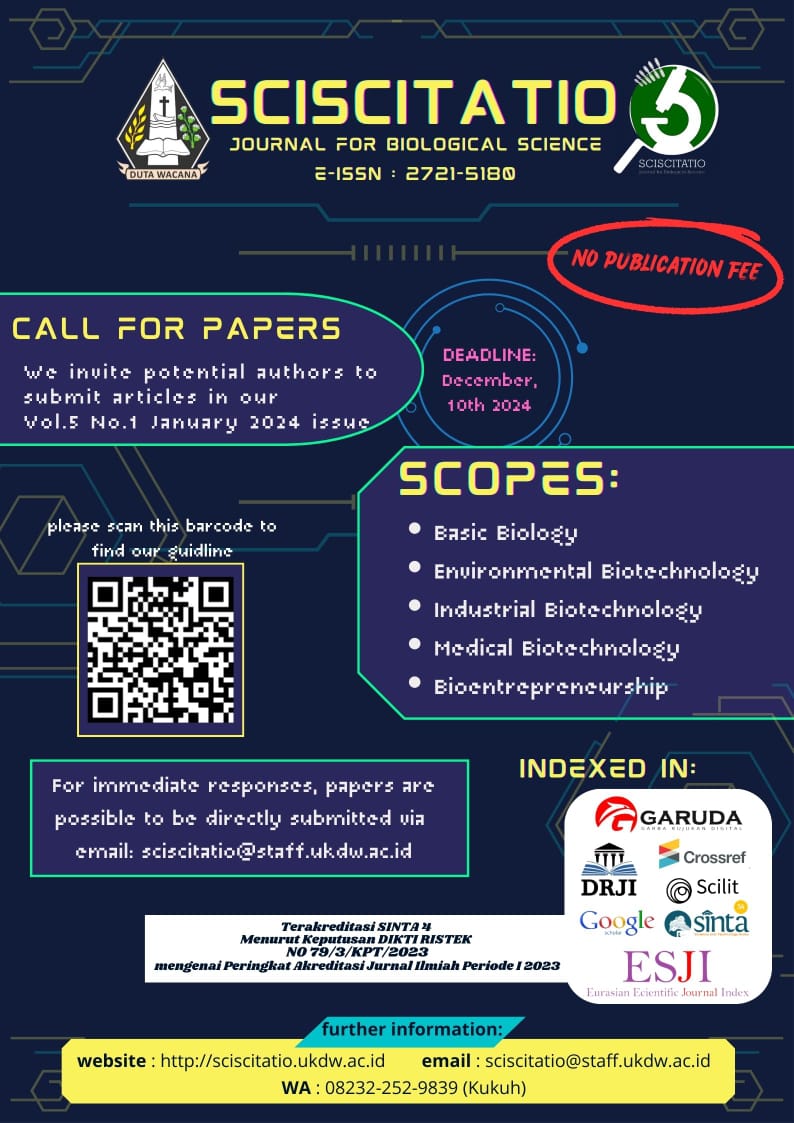Aktivitas Antibakteri Metabolit Rhizopus sp. Asal Usar Daun Jati terhadap Salmonella typhi
DOI:
https://doi.org/10.21460/sciscitatio.2023.42.130Keywords:
Rhizopus sp., usar daun jati, metabolit, antibakteri, Salmonella typhiAbstract
Kapang Rhizopus sp. berperan sebagai inokulum utama dalam fermentasi tempe. Inokulum dalam fermentasi tempe juga dapat diperoleh secara alami dari usar daun jati. Rhizopus sp. yang tumbuh pada kedelai akan menghasilkan metabolit yang telah dikaji sebagai antidiare yang disebabkan bakteri Salmonella typhi sebagai penyebab demam tifoid yang masih menjadi penyakit endemis di Indonesia. Penelitian ini bertujuan untuk mempelajari aktivitas antibakteri metabolit Rhizopus sp. asal usar daun jati terhadap S. typhi. Metabolit Rhizopus sp. diproduksi pada media Sabouraud Dextrose Broth (SDB) selama 5 hari. Uji antibakteri metabolit mengunakan metode difusi kertas. Isolasi dari usar daun jati memperoleh satu isolat kapang yang teridentifikasi Rhizopus sp. Hasil uji menunjukkan bahwa crude metabolit Rhizopus sp. mempunyai aktivitas antibakteri kategori sedang terhadap S. typhi.
References
Ayun, Q., Suryani, S., & Kurnia, C. (2022). Identifikasi Kapang Pada Tempe Bungkus Daun Pisang Dan Plastik asal Pengrajin Tempe Jatiasih, Bekasi.Bioed: Jurnal Pendidikan Biologi, 10(2),45-51. https://doi.org/http://dx.doi.org/10.25157/jpb.v10i2.8685
Babu, P. D., Bhakyaraj, R., & Vidhyalakshmi, R. (2009). A Loa Cost Nutritious Food Tempe. World Journal of Diary and Food Sciences, 4(1), 22-27.
Brooks, G. F., Carroll, K. C., Butel, J. s, Morse, S. A., & Mietzner, T. A. (2012). Jawetz, Melnick, & Adelberg Mikrobiologi Kedokteran (A. Adityaputri, C. Salim,F. Sandra, M. Iskandar, Nalurita, P.Ayuningtyas, R. Soeharsono, Rifky, & S. Debby (eds.); 25th ed.). Penerbit Buku Kedokteran EGC.
CLSI. (2019). M100 Performance Standards for Antimicrobial Susceptibility Testing (29th ed., Vol. 39, Issue 1). http://www.emeraldinsight.com/ doi/10.1108/08876049410065598
Codex Alimentarius. (2015). Regional standard for Tempe (CODEX STAN 313R-2013).
Desbois, A. P., & Smith, V. J. (2010).Antibacterial Free Fatty Acids: Activities, Mechanisms of Action and Biotechnological Potential. Applied Microbiology and Biotechnology, 85,1629-1642. https://doi.org/10.1007/s00253-009-2355-3
Dewi, R. S., & Aziz, S. (2011). Isolasi Rhizopus oligosporus Pada Beberapa Inokulum Tempe di Kabupeten Banyumas. Molekul, 6(2), 93-104.
Fadahunsi, I. F., Ogunbanwo, S. T., & Ogundana, D. T. (2013). Heat Stability And Optimization Of Invitro Antimicrobial Activity Of Metabolites Produced By Rhizopus oligosporus NRRL 2710 Against Some Pathogenic Bacteria. Trakia Journal of Sciences, 11(2),110-117.
Faisal, M. ., & Prasad, L. (2016). A Potential Source of Methyl-Eugenol From Secondary Metabolite of Rhizopus oryzae 6975. International Journal of Applied Biology and Pharmaceutical Technology, 7(4), 187-192. https://doi.org/10.21276/Ijabpt.2016.7.4.22
Guo, Y., Yan, Q., Jiang, Z., Teng, C., & Wang, X. (2010). Efficient production of lactic acid from sucrose and corncob hydrolysate by a newly isolated Rhizopus oryzae GY18. Journal of Industrial Microbiology and Biotechnology, 37(11), 1137-1143. https:// doi.org/10.1007/s10295-010-0761-2
Iqbal, M., Amin, M., Iqbal, Z., Bibi, H., Iqbal, A., Din, Z., Suleman, M., & Shah, H. .(2014). Antimicrobial, cytotoxic and phytotoxic potency of ethyl acetate extract of Rhizopus stolonifer culture. Tropical Journal of Pharmaceutical Research, 13(1), 87-92. https://doi.org/10.4314/tjpr.v13i1.13
Ito, M., Ito, T., Aoki, H., Nishioka, K.,Shiokawa, T., Tada, H., Takeuchi, Y., Takeyasu, N., Yamamoto, T., & Takashiba, S. (2020). Isolation and Identification of the Antimicrobial Substance included in Tempeh using Rhizopus stolonifer NBRC 30816 for fermentation. International Journal of Food Microbiology, 325, 1-9. https://doi.org/https://doi.org/10.1016/j. ijfoodmicro.2020.108645
Khikmah, N., & Haloho, A. S. (2021). Uji Antibakteri Rhizopus sp. Asal Inokulum Tempe terhadap Vibrio cholerae. Sciscitatio, 2(2), 82-89. https://doi.org/10.21460/sciscitatio.2021.22.72
Kiers, J. L., Meijer, J. C., Nout, M. J. R.,Rombouts, F. M., Nabuurs, M. J. A.,& Van Der Meulen, J. (2003). Effect of fermented soya beans on diarrhoea and feed efficiency in weaned piglets.Journal of Applied Microbiology, 95(3), 545-552. https://doi.org/10.1046/j.1365-2672.2003.02011.x
Kusumah, D., Wakui, M., Murakami, M., Xie, X., Yukihito, K., & Maeda, I. (2020). Linoleic Acid, alpha-Linolenic Acid,and Monolinolenins as Antibacterial Substances in the Heat-Processed Soybean Fermented with Rhizopus oligosporus. Bioscience, Biotechnology and Biochemistry, 84(6), 1285-1290. https://doi.org/10.1080/09168451.20 20.1731299
Liasi, S. A., Azmi, T. I., Hassan, M. D., Shuhaimi, M., Rosfarizan, M., & Ariff, A. B. (2009). Antimicrobial Activity and Antibiotic Sensitivity of Three Isolates of Lactic Acid Bacteria from Fermented Fish Product, Budu. Malaysian Journal of Microbiology, 5(1), 33-37. https://doi. org/10.21161/mjm.15008
Maskar, D. (2013). Ayo Makan Tempe, Bisa Jadi Obat Diare dan Mampu Cegah Kanker. https://finance.detik.com/ berita-ekonomi-bisnis/d-2271201/ayomakan-tempe-bisa-jadi-obat-diaredan-mampu-cegah-kanker
McCue, P., Lin, Y. T., Labbe, R. G., & Shetty, K. (2004). Sprouting and solid-state bioprocessing by Rhizopus oligosporus increase the In Vitro antibacterial activity of aqueous soybean extracts against Helicobacter pylori. Food Biotechnology, 18(2), 229-249. https:// doi.org/10.1081/FBT-200025669
Oda, Y., Saito, K., Yamauchi, H., & Mori, M. (2002). Lactic Acid Fermentation of Potato Pulp by the Fungus Rhizopus oryzae. Current Microbiology, 45, 1-4.https://doi.org/10.1007/s00284-001-0048-y
Parada, J. L., Caron, C. R., Medeiros, A. B. P., & Soccol, C. R. (2007). Bacteriocins from Lactic Acid Bacteria: Purification, Properties and Use as Biopreservatives.Brazilian Archives of Biology and Technology, 50(3), 521-542. https://doi.org/10.1590/s1516-89132007000300018
Peeran, M. ., Prasad, L., & Kamil, D. (2018).Characterization of Secondary Metabolites from Rhizopus oryzae and Its Effect on Plant Pathogens. International Journal of Current Microbiology and Applied Sciences, 7(03),705-710. https://doi.org/10.20546/ijcmas.2018.703.082
Samson, R. A., Hoekstra, E. S., & Frisvad, J. C. (2004). Introduction To Food And Air Borne Fungi (7th ed.). CBS.
Sohail, Afzal, M., Iqbal, Z., Sheena, Khan,S. ., Rahman, U., Khan, W., Asghar, A., Ullah, M., & Numan, M. (2014). Antimicrobial activity of mycelial extracts of Rhizopus stolonifer against different fungal and bacterial pathogenic strains. International Journal of Biosciences (IJB), 4(7), 276-282,https://doi.org/10.12692/ijb/4.7.276-282
Sukron, M. A., Suarsini, E., & Witjoro, A. (2014). Pengaruh Ekstrak Tempe Kedelai (Glycine max (L) Merr.) dan Ekstrak Inokulum Kapang Tempe Terhadap Penghambat Esherichia coli Secara in Vitro. Universitas Negeri Malang, Malang.
Suskovic, J., Kos, B., Beganovic, J., Pavunc, A. L., Habjanic, K., & Matoc, S. (2010). Antimicrobial Activity - The most Important Property of Probiotic and Starter Lactic Acid Bacteria. Food Technology and Biotechnology, 48(3),296-307.
Wipradnyadewi, P. A. S., Rahayu, E. S.,& Raharjo, S. (2005). Isolasi dan Identifikasi Rhizopus Oligosporus pada Beberapa Inokulum Tempe. Jurnal Agrotekno, 11(2), 1-9.
Yoon, B. K., Jackman, J. A., Valle-González, E. R., & Cho, N. J. (2018). Antibacterial Free Fatty Acids and Monoglycerides: Biological Activities, Experimental Testing, and Therapeutic Applications. In International Journal of Molecular Sciences, 19, 1-40. https://doi. org/10.3390/ijms19041114
Downloads
Published
How to Cite
Issue
Section
License

This work is licensed under a Creative Commons Attribution-ShareAlike 4.0 International License.

